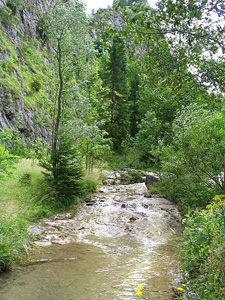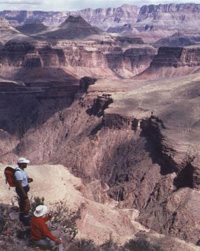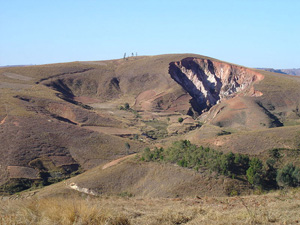Erosion
Rivers carry stuff. Sometimes this includes students on inner tubes, but it mostly includes soils and rock sediments picked up along the way. Rivers shape and change the landscape because of their running water. They are powerful agents of erosion. Stream erosion is much more powerful than sheet erosion, caused by a flood. Stream erosion is confined to channels, so it has a greater velocity and more energy. It carries away large amounts of soil and sediment.
Mountainous areas with high rainfall are especially vulnerable to stream erosion, but all rivers lead to some degree of erosion. Rivers eat away at the landscape by three main processes: removal of rock debris, downcutting of the river channel, and headward erosion. Click through the tabs to learn more about these three processes.
Removal of Rock Debris

One of the most important processes of stream erosion is the removal of rock debris, called regolith, created by weathering. Loose rock debris created by weathering is washed downslope and transported as sediment in rivers. A blanket of regolith is constantly being removed and transported to the sea by rivers. Of course, as it is removed, it is regenerated by the weathering of fresh bedrock below.
Downcutting

When you run sandpaper over wood, the wood is "sanded" away. You can see the tiny wood particles in the form of dust. Similarly, the abrasive action of sand and gravel being carried along on a river’s channel floor downcuts rocks. Like the sandpaper, sand and gravel cut through the bottom of the river, making the river valley deeper and deeper over time. One other interesting consequence of abrasion is the formation of features called potholes. When sand and gravel move along on a river floor, they are sometimes swirled around by the currents. The resulting rotational movement acts like a drill, cutting deep holes, called potholes, in the bedrock beneath a river. Canyons and gorges are often cut through landscapes by the action of downcutting.
Headward Erosion

While downcutting deepens a river, headward erosion extends and lengthens a river. Headward erosion is the tendency of a river to erode away upslope and increase the length of its valley until it reaches the drainage divide. At a river’s headwaters, water starts to create channels that become conduits for fast-moving water. As the water’s velocity and volume increase, so does its ability to erode. In this way, a stream erodes the rock and soil at its headwaters in the opposite direction that it flows. If headward erosion continues long enough, then the tributaries of one stream can extend upslope and divert another stream, through a process called stream piracy.